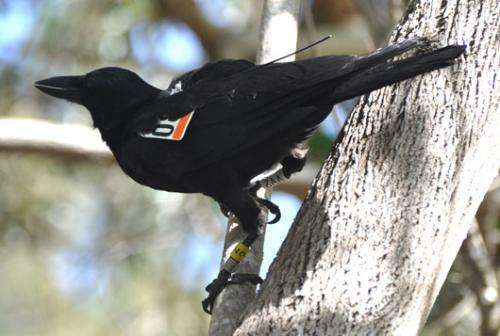Mapping the social networking of birds

(Phys.org)—A team, led by researchers at the Universities of St Andrews and Washington, used novel radio-transmitters to study the social networks of New Caledonian crows, a species renowned for using sophisticated foraging tools.
Data downloaded from the miniature tracking devices, which were attached to the birds as back-packs, enabled the researchers to infer their birds' social relationships, revealing a surprising amount of contacts.
Unlike conventional wildlife radio-tags, these new devices can both transmit and receive radio-signals.
Crucially, at the analysis stage, this allows the researchers to infer from the data how close two birds were to each other, based on the basic premise that close tags should exchange stronger radio-signals than tags that are farther apart.
The study is a crucial step towards understanding how tool-related information may diffuse in wild crow populations. A report of the research is published this week in Current Biology.
New Caledonian crows are the most prolific avian tool users. In the wild, they use at least three distinct tool types to extract invertebrate prey from deadwood and vegetation, with some of their tools requiring complex manufacture, modification and/or deployment.
Some scientists have suggested that certain aspects of these crows' sophisticated tool-use behaviour may be the outcome of social transmission processes, where birds observe, and learn from, other individuals.
The study, which was funded by the UK's Biotechnology and Biological Sciences Research Council (BBSRC), examined whether such 'tool cultures' could exist in wild crow societies.
Dr Christian Rutz, a world-leading expert in the use of miniature electronic devices for studying the behaviour of wild animals (known as biologging) led the project.
He said: "Whenever two marked crows get close to each other, their tags exchange radio-signals. It is as if the birds are swapping business cards when they meet."
Plotting the social network revealed a highly interconnected population, in which most individuals associated at very close range with non-family members within just a few days. This illustrates considerable potential for the diffusion of social information in crow populations.
Dr Rutz, Reader in the School of Biology at the University of St Andrews, compared this to friendship networks in humans.
He added: "We all know how fast fads can spread, whether it is fashion or music preferences, or new consumer products. But, importantly, successful diffusion depends on people's ability to observe and copy other individuals' choices and behaviours.
"This is why we wanted to know how often crows meet other crows in the course of a week."
Dr Richard James, a physicist at the University of Bath who collaborated on the analysis of the data, said: "These tags produce the kind of information theoretical biologists have been waiting for.
"Datasets in our field are usually quite sparse, because of the difficulty of observing wild animals."
Dr James St Clair, a Postdoctoral Fellow in the School of Biology at the University of St Andrews, said: "In this study, we have been able to look at association patterns minute-by-minute, building an unusually comprehensive picture of these birds' social lives."
Dr John Burt and Professor Brian Otis from the University of Washington, invented the tracking technology employed by the study, called "Encounternet".
This new technology is likely to revolutionise the fast-moving field of animal social network analysis, and has considerable potential for a wide range of other applications.
Dr Burt said: "It was fantastic for us to see these tags being deployed on wild animals. The technology worked beautifully and generated some fascinating new insights into the biology of these remarkable birds."
The results of the present study show that crows indeed have plentiful opportunities to learn from other birds, even unrelated individuals. The next step will be to investigate whether social transmission of information actually takes place during encounters.
Journal information: Current Biology
Provided by University of St Andrews



















